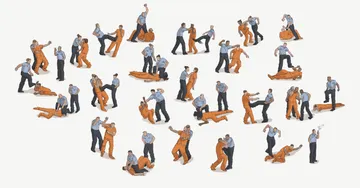The politicians and pundits, the academics and activists have argued for months over whether America is in the grip of a new crime wave. A few weeks ago, the FBI appeared to lay to rest the argument when it published its annual figures on crime reports to local police departments: the number of violent crimes reported was, indeed, up 3.9 percent last year, but was still near its lowest point in decades.
Today, a new report from another wing of the Justice Department, the Bureau of Justice Statistics, presents a slightly different perspective and underscores how difficult it can be to try to measure crime in America.
The latest edition of the National Criminal Victimization Survey, or NCVS, found that the rate of violent crime victimization in 2015 was statistically the same as the year before. That also suggests that roughly the same number of violent crimes—including rape, robbery, assault, domestic violence—were committed last year as in 2014. At the same time, the number of people who were victims of violent crime fell by 10 percent, according to the survey.
The survey also found that the rate of property crime dropped by almost 7 percent.
What didn’t change last year was the willingness (or unwillingness) of victims of violent crimes to notify the police. In fewer than half of violent crimes did victims call the cops, roughly the same as the year before and statistically the same percentage as in the early 1990s.
Where the Bureau’s survey agrees with the FBI’s Uniform Crime Reporting program is that crime is near its lowest level in decades, no matter how you count it.
“It's not a question of which one is ‘better,’ but rather what they suggest when viewed together. Which means that the NCVS results do not necessarily mean the UCR ones are ‘wrong’ (or vice versa), but they certainly provide yet another reason to view claims that crime is clearly rising with caution, and to make sure we do not over-react in response,” said John Pfaff, a law professor at Fordham University.
The survey was first begun in the early 1970s and was intended to help complement, and fill in the gaps of, the FBI’s much older Uniform Crime Reporting program. According to James Lynch, former director of the Bureau of Justice Statistics, the survey originated in the social unrest of the era.
“There was little confidence in the police, at the same time, people were pouring a lot of money into the police to make them better,” said Lynch, who now chairs the Department of Criminology and Criminal Justice at the University of Maryland. “People needed a measure of crime that was independent of the police.”
The survey’s findings are based on interviews with more than 160,000 people. The respondents are asked about crimes of which they were the victim over the previous six months. Based on the answers of the respondents, statisticians estimate national figures for each type of crime.
While the FBI’s figures rely on the police departments to voluntarily forward counts of crimes reported to them, the victim survey has its shortcomings as well. It only interviews victims aged 12 and older, and it may under-represent the homeless or populations who move frequently. Because it relies on interviews with the victims themselves, it also omits the crime of homicide.
Janet Lauritsen, a professor of criminology at the University of Missouri-St. Louis, has studied the survey and how it has compared over the decades to the FBI’s Uniform Crime Reporting figures.
“You have to look at both series of data if you’re going to talk about national crime trends,” said Lauritsen, adding, “You try to use both data sources where you can to see where there might be problems in the police data. The limit of the NCVS is you can’t get the subnational estimates easily. It’s designed for national level estimates…. This doesn’t mean that for a specific jurisdiction that you can say there aren’t cities with bad recording practices and lower victim reporting. These are things we just don’t know the answers to.”
Only a handful of crime categories saw a rise according to the survey’s respondents last year, including serious domestic violence and intimate partner violence, which is not tracked by the FBI’s crime data. Significantly, the number of rapes and sexual assaults rose by more than 50 percent in that year.
“Rape and sexual assault is up, the other two major categories are aggravated assault and serious violent crime involving weapons, that’s also dropped,” said Lynch, comparing the differing results of the two reports. “That’s not a radically different story, but that’s a different story.”
The Bureau takes pains to explain in its report that this number should be considered with great care. Because it is based on survey responses, the estimate of 431,800 sexual assaults last year is derived from reports by 103 interviewees, about 34 more than the previous year. As the Bureau writes, “Therefore, small absolute changes and fluctuations in the rates of victimization can result in larger year-to-year change estimates.”
